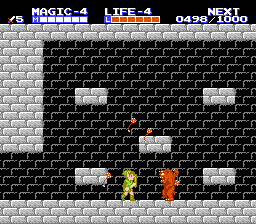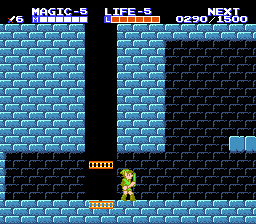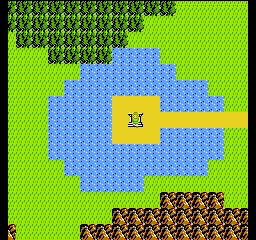The Adventure of Link Regional Differences
| This article is a stub. You can help the Zelda Dungeon Wiki by expanding it. |
The Adventure of Link was originally released on the Famicom Disk System in Japan during January of 1987. Over a year and a half later, it was released in Europe and the United States on the Nintendo Entertainment System and had a substantial number of differences. Below is a complete listing of all the regional differences of The Adventure of Link.[1]
Title Screen
- The Famicom version has the Japanese logo and also has the words, PUSH START. This was removed in the US and PAL versions of the game.
- The Pal version has the bottom half of its background moved up one line. This could possibly be to remove the graphical flickering that was present in the US version.[2]
| Famicom | NES US | NES PAL |
|---|---|---|
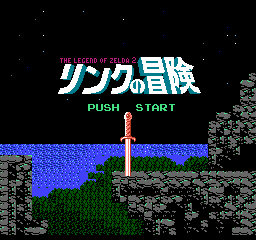 |
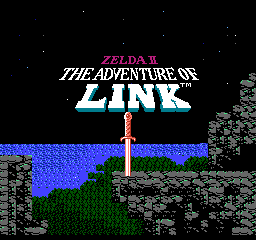 |
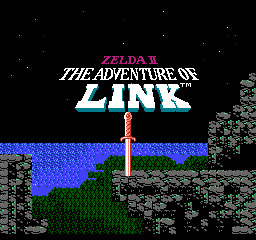
|
Loading and Disc Swapping
- In the Famicom version, when Link travels into a Town, Dungeon, or Cave, the game will Pause momentarily. It will say W A I T on the screen while it loads. With the NES version being on a cartridge, there are no loading screens.
- The Famicom version is on a Disc, with there being information on both sides of the Disc. Disc Side A consists of the Title Screen, the Menu, and the Great Palace. With the remaining of the game taking place on Side B.
Story
The introduction story of the Famicom Disk System has some English text and it is of significant difference than the NES version.
- Ganon is referred to as Gannon in the Famicom version, but is changed to Ganon in the NES version.
- The Famicom version refers to Another Sleeping Princess Zelda, whereas the NES version simply refers to her as Princess Zelda. In this case the Famicom version is more appropriate, as the Zelda in Adventure of Link is a different Zelda than the one that appeared in The Legend of Zelda. She is the original Princess Zelda and all other girls born into the Royal Family after her are named Zelda. This change is likely just to provide ease of understanding of the story, whereas the more detailed information is in the Instructional Manual.
- There are a number of spelling and grammatical errors, along with name changes, including the word Tryforce instead of Triforce, Disvalley instead of Valley of Death, and Great Sanctuary instead of Great Palace.
| Famicom | NES |
|---|---|
| SEVERAL YEARS AFTER GANNON WAS DESTROYED,LINK LEARNS FROM IMPA ABOUT THE ANOTH- ER SLEEPING PRINCESS ZELDA. HE IS TOLD SHE CAN ONLY AWAKEN WITH THE NO.3 TRY- FORCE SEALED IN THE GREAT SANCTUARY AT DISVALLEY. TO REMOVE THE SEAL, CRYSTALS MUST BE EMBEDDED INTO A STONE STATUE STANDING IN 6 SANCTUARIS. LINK SETS OUT ON AN ADVENTUROUS QUEST.... ©1987 NINTENDO |
AFTER GANON WAS DESTROYED, IMPA TOLD LINK A SLEEPING SPELL WAS CAST ON PRINCESS ZELDA. SHE WILL WAKE ONLY WITH THE POWER OF NO.3 TRIFORCE SEALED IN A PALACE IN HYRULE. TO BREAK THE SEAL,CRYSTALS MUST BE PLACED IN STATUES IN 6 WELL GUARDED PALACES. LINK SET OUT ON HIS MOST ADVENTURESOME QUEST YET... ©1987 NINTENDO |
Game Over
- The background of the Game Over screen on the Famicom version is simply just black, where it is Red with a silhouette of Ganon.
- The Famicom version has the spelling of Gannon instead of Ganon.
- In the Famicom version, the audio that plays here is almost an elephant sounding noise. It is a similar noise that can be heard during some of the boss battles, with Link fights Mazura and Barba.
| Famicom | NES |
|---|---|
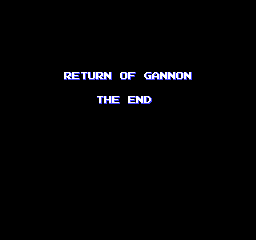 |
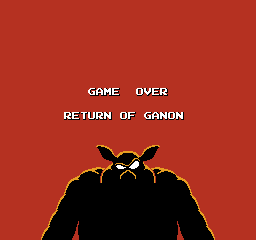
|
North Castle
- At the very start of the game, the North Castle is decorated differently. In the NES version, the pillars continue off to the side of the altar until the end of the screen.
- There are two torches on the sides of Zelda. However, these torches are not found during the ending portion of the game.
| Famicom | 
|
| NES | 
|
Link Sprites
- In the NES Version, an additional pixel was adding to Link's base sprite, giving him more of a visual mouth.
- In the Famicom version, Link collected all items by stabbing them with his sword. This is similar to how Link collects all Keys, Point Bags, and Magic Jars in both versions of the game. However, in the NES version, Link can simply walk into some of the items and will pick them up. This caused two sprite images to appear more commonly in the NES version.
- Additionally, this change allows Link to use the Fairy Spell and still collect items. In the Famicom version, this was not possible, as Link needed to stab the items with his sword.
- A similar version of the sprite of Link holding up an object is still present in the Famicom version, as it is used at the very end of the game, when Link is holding the Triforce.
| Famicom | NES |
|---|---|
Overworld Enemy Sprites
- While wandering in the Overworld, there are three different types of encounters. In the Famicom, these were represented by small ghost looking blobs, with weak encounters being a tan color, strong encounters being blue, and fairies being orange. In the NES version, these sprites were changed to make it much easier to understand which encounters were difficult, and when a Fairy is around.
| Famicom | NES |
|---|---|
| Famicom | NES |
|---|---|
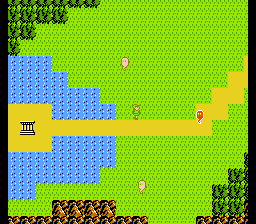 |
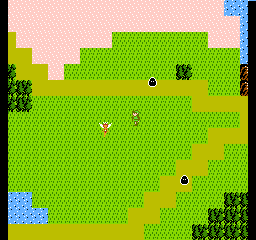
|
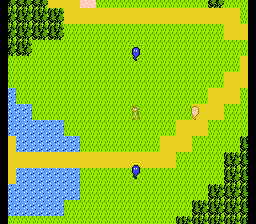 |
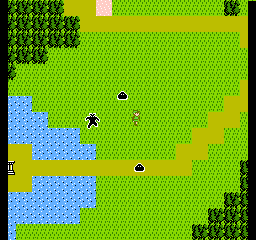
|
Sprite Changes
- The Trophy had an altered sprite. It was also referred to as Megami Zou in the Japanese version, translating to Goddess Statue.
- The Water of Life also had an altered sprite.
- The Kidnapped Child appears as if he is tied up in the Famicom version. This change could be due to the Japanese version requiring the player to stab his sword at items in order to pick them up. Thus, in the Japanese version, attacking with your sword is much like cutting the ropes that tied up him.
| Famicom | NES | |
|---|---|---|
| Trophy | 
| |
| Water of Life | ||
| Kidnapped Child |
Palace Backgrounds
In the Famicom Disc Version, there are only two different color palettes for the first six palaces. The first, second, and fifth palaces all use a gray color palette, whereas the third, fourth, and six palaces use a blue color palette. They all have the same standard looking bricks.
In the NES version, each of the six dungeons has a different color palette, as well as a different background design. This includes different designs for the background pillars as well.
In both versions, the Great Palace has a unique background with a gold color palette.
Animated Water
In the Famicom version of the game, the water in the Overworld is animated, rotating between three distinctive sprite images, giving it the appearance of animation. In the NES version, this is removed and the water screens are a set sprite image.
Level-Up System
In the Famicom version, there is no distinction in the number of experience points needed to upgrade Attack, Life, and Magic. Instead, all are worth the same value, where after acquiring 50 experience points, Link can upgrade either Attack, Magic, or Life. In the NES version, the three upgrades were given a staggering number of experience points to upgrade, with the overall values being significantly higher.
When Link chooses to save and quit, in the NES version, Link will retain his exact same levels. However, in the Famicom version, the levels will be reduced to whichever currently has the lowest level. For example, if Link has a Level 7 Attack, Level 5 Magic, and Level 4 Life, when he saves and quits, all of his levels will be at Level 4.
Famicom Version
| Level | Attack | Magic | Life |
|---|---|---|---|
| 1 | - | - | - |
| 2 | 50 | 50 | 50 |
| 3 | 300 | 300 | 300 |
| 4 | 700 | 700 | 700 |
| 5 | 1000 | 1000 | 1000 |
| 6 | 1500 | 1500 | 1500 |
| 7 | 2500 | 2500 | 2500 |
| 8 | 4000 | 4000 | 4000 |
| Extra Life | 4000 | 4000 | 4000 |
NES Version
| Level | Attack | Magic | Life |
|---|---|---|---|
| 1 | - | - | - |
| 2 | 200 | 100 | 50 |
| 3 | 500 | 300 | 150 |
| 4 | 1000 | 700 | 400 |
| 5 | 2000 | 1000 | 800 |
| 6 | 3000 | 2000 | 1500 |
| 7 | 5000 | 3000 | 2500 |
| 8 | 8000 | 5000 | 4000 |
| Extra Life | 9000 | 9000 | 9000 |
Music and Sound Effects
The Famicom Disk System has an extra sound channel, so when the game was ported to the NES, many of the games songs and sound effects needed to be altered.
- Many of the basic sound effects, such as when link uses a spell, unlocks a door, and finds a fairy are slightly different.
- The Battle music is completely different. The Famicom version is a bit shorter, with it running on a 20-second loop, as opposed to the 30-second loop version for the NES. The Famicom version would later be remixed and used as the Mini-Boss battle theme from The Minish Cap
- When Link dies, the short sound effect that plays is different in the Famicom version.
- Ganon's Game Over theme has more of an elephant sound effect, which also plays during some of the boss battles. Whereas the NES version has Ganon's laugh.
- The Title Theme is the same song in both versions, but the beginning portion sounds much different.
- When entering a battle scene, the short chime is much different, being much louder and almost sounds like the traditional, item catch song from later titles. The NES version has more of a seamless whoosh sound effect.
- The Boss Battle theme in the NES version is extended and have parts done in a different pitch, allowing it to sound less repetitive.
- When Text appears in the NES version, it sounds like a typewriter, while the sound effects of the text in the Famicom, almost come across as some sort of alien sound effect.



